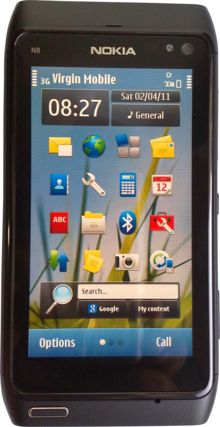This article is written like a manual or guide. (February 2024) |
 The Nokia N8 is the first device to run on the Symbian^3 mobile operating system | |
| Manufacturer | Nokia |
|---|---|
| Slogan | What will you do with it? |
| Series | Nseries |
| Availability by region | 30 September 2010 (Finland)[1] 22 October 2010 (United Kingdom) |
| Predecessor | Nokia N97 Nokia N86 8MP |
| Successor | Nokia 808 PureView Nokia N9 Nokia Lumia 800 |
| Related | Nokia E7-00 |
| Compatible networks | |
| Form factor | Slate bar |
| Dimensions | 113.5mm × 59 mm × 12.9 mm (4.47 in × 2.32 in × 0.51 in) |
| Weight | 135 g (4.8 oz) |
| Operating system | Symbian^3, upgradeable to Nokia Belle |
| CPU |
|
| Memory | 256 MB SDRAM[2] |
| Storage | |
| Removable storage | Hot swap microSD; up to 32 GB supported w/ microSDHC support |
| Battery | BL-4D 1200 mAh Li-Ion fixed battery |
| Rear camera | 12.1 megapixels with Carl Zeiss optics and xenon flash, 16:9 720p video with continuous AutoFocus, 30 frame/s |
| Front camera | VGA, for video calling |
| Display | 210 ppi pixel density 640 × 360 px (nHD), 3.5" capacitive, multi-touch display with AMOLED technology |
| Connectivity |
|
| Data inputs |
|
| Development status | Available 1 October 2010, Out of production |
The Nokia N8 is a touchscreen-based smartphone developed by Nokia. Announced on 27 April 2010, the Nokia N8 was the first device to run on the Symbian^3 mobile operating system and it was the company's flagship device for the year.[4] It was released on 30 September 2010 at the Nokia Online Store before being released in markets around the world on 1 October 2010.[5] There were two versions made, the N8 and the N8-00. The N8 was made for Vodafone and locked to its networks,[6] and the N8-00 was made by Microsoft and open network.[7]
The N8 has a 3.5-inch AMOLED display with 16 gigabytes of mass memory, and features a 12-megapixel camera, the second time a camera of such megapixel count was used (the first one being the Sony Ericsson Satio in 2009) with a Xenon flash (like the Nokia N82) and with a very large 1/1.83" sensor size (larger than most point-and-shoot cameras of the time).[8] It also has 720p HD video recording, a pentaband 3.5G radio, and an FM transmitter. Among the connectivity features are an HDMI output, USB On-The-Go, and Wi-Fi 802.11 b/g/n.[9]
The N8 was an important device for Nokia in its bid against increasing competition in the smartphone industry, and its revamped Symbian^3 software was also important. The device was delayed several times pushing its release date by several months, which had a negative impact on the company.[10][11] Despite mixed views on the Symbian software, the N8's hardware build and camera quality were very well received, with many calling it the "best camera phone".[12][13] The N8 would also become Nokia's last flagship device running Symbian, due to Nokia Lumia 800 in 2011 which ran on Windows Phone software. The N8's Symbian successor, Nokia 808 PureView, appeared in 2012.[14]
- ^ "Nokia N8 is shipping". Nokia Conversations. 30 September 2010. Archived from the original on 7 July 2012. Retrieved 13 December 2010.
- ^ a b c d "Nokia N8 Device Details at Forum Nokia". Forum Nokia. 27 April 2010. Archived from the original on 28 April 2012.
- ^ "Nokia N8 Teardown". October 2010.
- ^ "Nokia N8 Boasts Beefy Specs, Revamped Symbian 3 OS".
- ^ Stan Schroeder (8 September 2010). "Nokia N8 Release Date: End of September in the Online Shop, October 1 in UK Stores". Mashable.com. Retrieved 1 August 2011.
- ^ "Nokia N8 – smartphone – GSM / UMTS Series Specs". cnet.com. cnet. Retrieved 23 March 2021.
- ^ "Nokia N8-00 – smartphone – GSM / UMTS Series Specs". cnet.com. cnet. Retrieved 23 March 2021.
- ^ "Nokia N8 Review: Nokia's New Flagship".
- ^ "Nokia announces N8 device with 5-band WCDMA technology". ZDNet.com. 27 April 2010. Archived from the original on 29 April 2010.
- ^ "Nokia N8 release date delayed again". uswitch.com. Archived from the original on 6 October 2018.
- ^ "Nokia delays flagship N8 again". Reuters. 21 September 2010.
- ^ "Nokia N8: The Best Camera Phone in the World". 16 September 2011.
- ^ "Why the Nokia N8 is still the best camera phone !".
- ^ "Nokia N8 successor to offer optical zoom, Symbian". 8 November 2011.